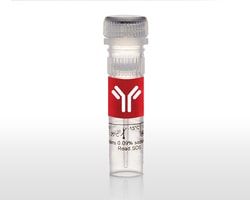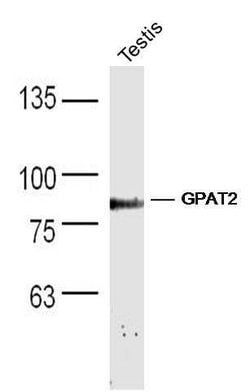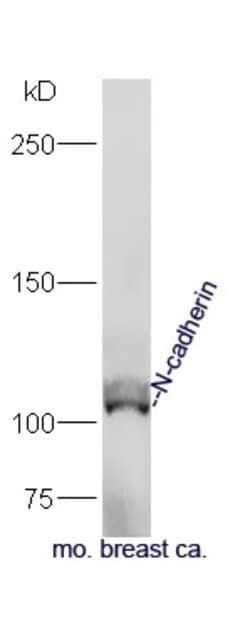50-198-1615
GDAP1 Rabbit anti-Human, Polyclonal, Bioss
Manufacturer: Bioss
Select a Size
| Pack Size | SKU | Availability | Price |
|---|---|---|---|
| Each of 1 | 50-198-1615-Each-of-1 | In Stock | ₹ 38,381.25 |
50-198-1615 - Each of 1
In Stock
Quantity
1
Base Price: ₹ 38,381.25
GST (18%): ₹ 6,908.625
Total Price: ₹ 45,289.875
Antigen
GDAP1
Classification
Polyclonal
Conjugate
Unconjugated
Gene
GDAP1
Gene Alias
Charcot-Marie-Tooth neuropathy 4A; CMT4; CMT4A; CMTRIA; ganglioside induced differentiation associated protein 1; Ganglioside-induced differentiation-associated protein 1; ganglioside-induced differentiation-associated-protein 1; Gdap1
Host Species
Rabbit
Purification Method
Protein A
Regulatory Status
RUO
Gene ID (Entrez)
54332
Content And Storage
-20°C
Form
Liquid
Applications
Immunofluorescence, Immunohistochemistry (Paraffin), Western Blot
Concentration
1 μg/mL
Formulation
PBS with 1% BSA, 50% glycerol and 0.09% sodium azide; pH
Gene Accession No.
Q8TB36
Gene Symbols
GDAP1
Immunogen
KLH conjugated synthetic peptide derived from human GDAP1.
Quantity
100 μL
Primary or Secondary
Primary
Target Species
Human
Product Type
Antibody
Isotype
IgG
Description
- Glutathione S-transferases (GSTs) function to conjugate reduced glutathione to many exogenous and endogenous hydrophobic electrophiles
- Although it shares the carboxy and amino-terminal glutathione S-transferase domains, GDAP1 (ganglioside-induced differentiation-associated protein 1) is characterized as a GST-like protein because it contains an extended GST domain II and a predicted transmembrane domain, two characteristics which are unusual for GST family members
- GDAP1 may function in a signal transduction pathway that is responsible for ganglioside-induced neurite differentiation and also may play a role in protecting myelin membranes from free-radical damage
- Mutations in the gene encoding GDAP1 is the cause of many forms of Charcot-Marie-Tooth disease, a common inherited disorder of the peripheral nervous system that is characterized by reduced nerve conduction velocities, slow progressive distal muscle atrophy and absent deep tendon reflexes.
Compare Similar Items
Show Difference
Antigen: GDAP1
Classification: Polyclonal
Conjugate: Unconjugated
Gene: GDAP1
Gene Alias: Charcot-Marie-Tooth neuropathy 4A; CMT4; CMT4A; CMTRIA; ganglioside induced differentiation associated protein 1; Ganglioside-induced differentiation-associated protein 1; ganglioside-induced differentiation-associated-protein 1; Gdap1
Host Species: Rabbit
Purification Method: Protein A
Regulatory Status: RUO
Gene ID (Entrez): 54332
Content And Storage: -20°C
Form: Liquid
Applications: Immunofluorescence, Immunohistochemistry (Paraffin), Western Blot
Concentration: 1 μg/mL
Formulation: PBS with 1% BSA, 50% glycerol and 0.09% sodium azide; pH
Gene Accession No.: Q8TB36
Gene Symbols: GDAP1
Immunogen: KLH conjugated synthetic peptide derived from human GDAP1.
Quantity: 100 μL
Primary or Secondary: Primary
Target Species: Human
Product Type: Antibody
Isotype: IgG
Antigen:
GDAP1
Classification:
Polyclonal
Conjugate:
Unconjugated
Gene:
GDAP1
Gene Alias:
Charcot-Marie-Tooth neuropathy 4A; CMT4; CMT4A; CMTRIA; ganglioside induced differentiation associated protein 1; Ganglioside-induced differentiation-associated protein 1; ganglioside-induced differentiation-associated-protein 1; Gdap1
Host Species:
Rabbit
Purification Method:
Protein A
Regulatory Status:
RUO
Gene ID (Entrez):
54332
Content And Storage:
-20°C
Form:
Liquid
Applications:
Immunofluorescence, Immunohistochemistry (Paraffin), Western Blot
Concentration:
1 μg/mL
Formulation:
PBS with 1% BSA, 50% glycerol and 0.09% sodium azide; pH
Gene Accession No.:
Q8TB36
Gene Symbols:
GDAP1
Immunogen:
KLH conjugated synthetic peptide derived from human GDAP1.
Quantity:
100 μL
Primary or Secondary:
Primary
Target Species:
Human
Product Type:
Antibody
Isotype:
IgG
Antigen: KCNQ2
Classification: Polyclonal
Conjugate: Unconjugated
Gene: KCNQ2
Gene Alias: BFNC; EBN; EBN1; ENB1; HNSPC; KCNA11; KCNQ2; KQT like 2; Kqt2; KQT-like 2; KV7.2; KVEBN1; mKQT2.3; mKQT2.4; Neuroblastoma-specific potassium channel subunit alpha KvLQT2; Nmf134; Potassium channel subunit alpha KvLQT2; potassium channel, voltage gated KQT-like subfamily Q, member 2; potassium channel, voltage-gated KQT-like subfamily Q, member 2; potassium voltage-gated channel KQT-like subfamily member 2.3; potassium voltage-gated channel KQT-like subfamily member 2.4; Potassium voltage-gated channel subfamily KQT member 2; potassium voltage-gated channel subfamily Q member 2; potassium voltage-gated channel, KQT-like subfamily, member 2; potassium voltage-gated channel, subfamily Q, member 2; Voltage-gated potassium channel subunit Kv7.2
Host Species: Rabbit
Purification Method: Protein A
Regulatory Status: RUO
Gene ID (Entrez): 3785
Content And Storage: -20°C
Form: Liquid
Applications: Flow Cytometry, Immunofluorescence, Immunohistochemistry (Paraffin), Western Blot
Concentration: 1 μg/mL
Formulation: PBS with 1% BSA, 50% glycerol and 0.09% sodium azide; pH
Gene Accession No.: O43526
Gene Symbols: KCNQ2
Immunogen: KLH conjugated synthetic peptide derived from human KCNQ2 .
Quantity: 100 μL
Primary or Secondary: Primary
Target Species: Human
Product Type: Antibody
Isotype: IgG
Antigen:
KCNQ2
Classification:
Polyclonal
Conjugate:
Unconjugated
Gene:
KCNQ2
Gene Alias:
BFNC; EBN; EBN1; ENB1; HNSPC; KCNA11; KCNQ2; KQT like 2; Kqt2; KQT-like 2; KV7.2; KVEBN1; mKQT2.3; mKQT2.4; Neuroblastoma-specific potassium channel subunit alpha KvLQT2; Nmf134; Potassium channel subunit alpha KvLQT2; potassium channel, voltage gated KQT-like subfamily Q, member 2; potassium channel, voltage-gated KQT-like subfamily Q, member 2; potassium voltage-gated channel KQT-like subfamily member 2.3; potassium voltage-gated channel KQT-like subfamily member 2.4; Potassium voltage-gated channel subfamily KQT member 2; potassium voltage-gated channel subfamily Q member 2; potassium voltage-gated channel, KQT-like subfamily, member 2; potassium voltage-gated channel, subfamily Q, member 2; Voltage-gated potassium channel subunit Kv7.2
Host Species:
Rabbit
Purification Method:
Protein A
Regulatory Status:
RUO
Gene ID (Entrez):
3785
Content And Storage:
-20°C
Form:
Liquid
Applications:
Flow Cytometry, Immunofluorescence, Immunohistochemistry (Paraffin), Western Blot
Concentration:
1 μg/mL
Formulation:
PBS with 1% BSA, 50% glycerol and 0.09% sodium azide; pH
Gene Accession No.:
O43526
Gene Symbols:
KCNQ2
Immunogen:
KLH conjugated synthetic peptide derived from human KCNQ2 .
Quantity:
100 μL
Primary or Secondary:
Primary
Target Species:
Human
Product Type:
Antibody
Isotype:
IgG
Antigen: KCTD7
Classification: Polyclonal
Conjugate: Unconjugated
Gene: KCTD7
Gene Alias: 4932409E18; 9430010P06Rik; BOS_22834; BTB/POZ domain-containing protein KCTD7; CLN14; EPM3; FLJ32069; KCTD7; LOC100345207; potassium channel tetramerisation domain containing 7; potassium channel tetramerisation domain containing 7-like; potassium channel tetramerization domain containing 7
Host Species: Rabbit
Purification Method: Protein A
Regulatory Status: RUO
Gene ID (Entrez): 154881
Content And Storage: -20°C
Form: Liquid
Applications: Immunofluorescence, Immunohistochemistry (Paraffin), Western Blot
Concentration: 1 μg/mL
Formulation: PBS with 1% BSA, 50% glycerol and 0.09% sodium azide; pH
Gene Accession No.: Q96MP8
Gene Symbols: KCTD7
Immunogen: KLH conjugated synthetic peptide derived from human KCTD7.
Quantity: 100 μL
Primary or Secondary: Primary
Target Species: Human
Product Type: Antibody
Isotype: IgG
Antigen:
KCTD7
Classification:
Polyclonal
Conjugate:
Unconjugated
Gene:
KCTD7
Gene Alias:
4932409E18; 9430010P06Rik; BOS_22834; BTB/POZ domain-containing protein KCTD7; CLN14; EPM3; FLJ32069; KCTD7; LOC100345207; potassium channel tetramerisation domain containing 7; potassium channel tetramerisation domain containing 7-like; potassium channel tetramerization domain containing 7
Host Species:
Rabbit
Purification Method:
Protein A
Regulatory Status:
RUO
Gene ID (Entrez):
154881
Content And Storage:
-20°C
Form:
Liquid
Applications:
Immunofluorescence, Immunohistochemistry (Paraffin), Western Blot
Concentration:
1 μg/mL
Formulation:
PBS with 1% BSA, 50% glycerol and 0.09% sodium azide; pH
Gene Accession No.:
Q96MP8
Gene Symbols:
KCTD7
Immunogen:
KLH conjugated synthetic peptide derived from human KCTD7.
Quantity:
100 μL
Primary or Secondary:
Primary
Target Species:
Human
Product Type:
Antibody
Isotype:
IgG
Antigen: N-cadherin
Classification: Polyclonal
Conjugate: Unconjugated
Gene: CDH2
Gene Alias: bib; BOS_22126; cadherin 2; cadherin 2 L homeolog; cadherin 2 type 1 N-cadherin (neuronal); cadherin 2, neuronal; cadherin 2, type 1; cadherin 2, type 1, N-cadherin (neuronal); cadherin 2, type 1, N-cadherin (neuronal) L homeolog; cadherin 2, type 1, N-cadherin a (neuronal); Cadherin2; Cadherin-2; Cadherin-2A; Cadherin-N; calcium-dependent adhesion protein, neuronal; CD325; CDH2; cdh2.L; cdh2a; cdh2-a; cdh2-b; CDHN; cdhn-a; CDw325; CDw325 antigen; cell adhesion molecule; glass onion; glo; I79_014914; labyrinth; LOC100344571; lyr; NCAD; N-Cad; N-cadherin; N-cadherin 1; N-cadherin A; N-cadherin precursor; N-cadherin-2; Neural cadherin; Neural cadherin A; Neural cadherin-2; neural-cadherin; pac; Parachute; wu:fb47h04; XELAEV_18031953mg; ZNCAD
Host Species: Rabbit
Purification Method: Protein A
Regulatory Status: RUO
Gene ID (Entrez): 1000
Content And Storage: -20°C
Form: Liquid
Applications: Immunofluorescence, Immunohistochemistry (Paraffin), Western Blot
Concentration: 1 μg/mL
Formulation: PBS with 1% BSA, 50% glycerol and 0.09% sodium azide; pH
Gene Accession No.: P19022
Gene Symbols: CDH2
Immunogen: KLH conjugated synthetic peptide derived from human N-cadherin.
Quantity: 100 μL
Primary or Secondary: Primary
Target Species: Human
Product Type: Antibody
Isotype: IgG
Antigen:
N-cadherin
Classification:
Polyclonal
Conjugate:
Unconjugated
Gene:
CDH2
Gene Alias:
bib; BOS_22126; cadherin 2; cadherin 2 L homeolog; cadherin 2 type 1 N-cadherin (neuronal); cadherin 2, neuronal; cadherin 2, type 1; cadherin 2, type 1, N-cadherin (neuronal); cadherin 2, type 1, N-cadherin (neuronal) L homeolog; cadherin 2, type 1, N-cadherin a (neuronal); Cadherin2; Cadherin-2; Cadherin-2A; Cadherin-N; calcium-dependent adhesion protein, neuronal; CD325; CDH2; cdh2.L; cdh2a; cdh2-a; cdh2-b; CDHN; cdhn-a; CDw325; CDw325 antigen; cell adhesion molecule; glass onion; glo; I79_014914; labyrinth; LOC100344571; lyr; NCAD; N-Cad; N-cadherin; N-cadherin 1; N-cadherin A; N-cadherin precursor; N-cadherin-2; Neural cadherin; Neural cadherin A; Neural cadherin-2; neural-cadherin; pac; Parachute; wu:fb47h04; XELAEV_18031953mg; ZNCAD
Host Species:
Rabbit
Purification Method:
Protein A
Regulatory Status:
RUO
Gene ID (Entrez):
1000
Content And Storage:
-20°C
Form:
Liquid
Applications:
Immunofluorescence, Immunohistochemistry (Paraffin), Western Blot
Concentration:
1 μg/mL
Formulation:
PBS with 1% BSA, 50% glycerol and 0.09% sodium azide; pH
Gene Accession No.:
P19022
Gene Symbols:
CDH2
Immunogen:
KLH conjugated synthetic peptide derived from human N-cadherin.
Quantity:
100 μL
Primary or Secondary:
Primary
Target Species:
Human
Product Type:
Antibody
Isotype:
IgG




